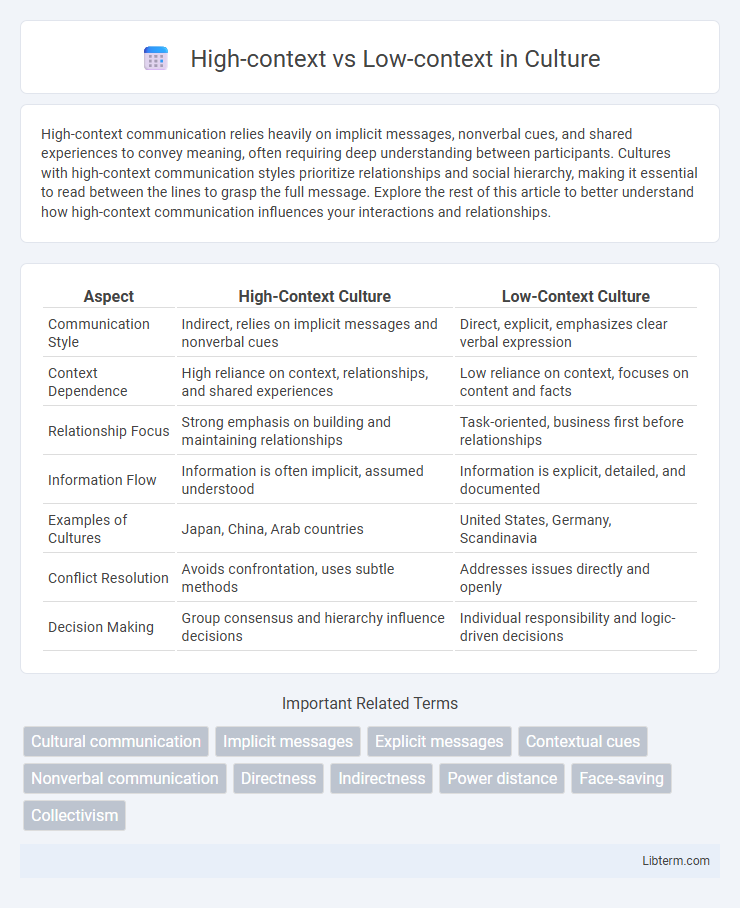High-context communication relies heavily on implicit messages, nonverbal cues, and shared experiences to convey meaning, often requiring deep understanding between participants. Cultures with high-context communication styles prioritize relationships and social hierarchy, making it essential to read between the lines to grasp the full message. Explore the rest of this article to better understand how high-context communication influences your interactions and relationships.
Table of Comparison
| Aspect | High-Context Culture | Low-Context Culture |
|---|---|---|
| Communication Style | Indirect, relies on implicit messages and nonverbal cues | Direct, explicit, emphasizes clear verbal expression |
| Context Dependence | High reliance on context, relationships, and shared experiences | Low reliance on context, focuses on content and facts |
| Relationship Focus | Strong emphasis on building and maintaining relationships | Task-oriented, business first before relationships |
| Information Flow | Information is often implicit, assumed understood | Information is explicit, detailed, and documented |
| Examples of Cultures | Japan, China, Arab countries | United States, Germany, Scandinavia |
| Conflict Resolution | Avoids confrontation, uses subtle methods | Addresses issues directly and openly |
| Decision Making | Group consensus and hierarchy influence decisions | Individual responsibility and logic-driven decisions |
Understanding High-context and Low-context Communication
High-context communication relies heavily on implicit messages, nonverbal cues, and shared cultural understanding, often found in collectivist societies like Japan and Arab cultures. Low-context communication depends on explicit, clear, and direct language, commonly seen in individualistic cultures such as the United States and Germany. Understanding these differences enhances cross-cultural interactions by improving message interpretation and reducing misunderstandings in global business and social environments.
Key Differences Between High-context and Low-context Cultures
High-context cultures rely heavily on implicit communication, nonverbal cues, and shared experiences to convey meaning, making context essential for understanding. Low-context cultures depend on explicit, direct language where information is spelled out clearly, minimizing the need for background knowledge. Key differences include communication style, with high-context favoring indirectness and relationship-based interactions, and low-context emphasizing clarity and individualism.
Characteristics of High-context Communication
High-context communication relies heavily on implicit messages, nonverbal cues, and shared cultural knowledge to convey meaning. It is characterized by a strong emphasis on relationships, trust, and situational context, often requiring participants to read between the lines. This communication style is common in collectivist cultures like Japan, China, and Arab countries, where group harmony and indirect expression are valued.
Characteristics of Low-context Communication
Low-context communication relies heavily on explicit, clear, and direct language where meanings are spelled out rather than implied. It emphasizes detailed verbal information, with little dependence on shared background knowledge or nonverbal cues, making it common in Western cultures such as the United States and Germany. This communication style values clarity, precision, and structured conversations to avoid misunderstandings.
Examples of High-context and Low-context Countries
High-context countries such as Japan, China, and Saudi Arabia rely heavily on implicit communication, shared experiences, and nonverbal cues to convey meaning in social and professional interactions. In contrast, low-context countries like the United States, Germany, and Switzerland emphasize explicit, direct communication with clear, detailed information to avoid misunderstandings. These cultural communication styles deeply influence international business practices, negotiation strategies, and interpersonal relationships across global contexts.
Impact of Context on Business and Negotiation
High-context cultures rely heavily on implicit communication, nonverbal cues, and established relationships, significantly influencing negotiation strategies by prioritizing trust and long-term connections over explicit agreements. Low-context cultures emphasize direct, clear, and precise communication, reducing ambiguity and fostering efficiency in business transactions through detailed contracts and straightforward dialogue. Understanding these differences enhances cross-cultural negotiation effectiveness, minimizing misunderstandings and optimizing collaboration in global business environments.
Challenges in Cross-cultural Communication
High-context communication relies heavily on implicit messages and nonverbal cues, creating challenges in cross-cultural interactions with low-context communicators who prefer explicit, direct language. Misunderstandings often arise when low-context individuals perceive high-context communication as vague or ambiguous, while high-context individuals may view low-context communication as blunt or insensitive. Effective cross-cultural communication requires awareness of these differences and adaptability to bridge the gap between implicit and explicit communication styles.
Strategies for Navigating Contextual Differences
Effective strategies for navigating high-context versus low-context communication involve recognizing the degree of implicit information and contextual cues used within interactions. In high-context cultures, prioritizing relationship-building, active listening, and interpreting non-verbal signals enhances understanding and reduces miscommunication. Conversely, in low-context environments, emphasizing clear, direct language and explicit information exchange ensures clarity and efficiency in communication.
The Role of Context in Building Relationships
High-context cultures rely heavily on shared experiences, nonverbal cues, and implicit communication to build trust and deepen relationships. Low-context cultures depend on explicit, clear, and direct information to establish connections, emphasizing verbal communication and factual accuracy. Understanding these differences is essential for effective interpersonal interactions and successful cross-cultural collaboration.
Adapting Communication Styles for Global Success
Effective global communication requires adapting to high-context cultures, where meaning is derived from implicit cues, relationships, and shared experiences, contrasting with low-context cultures that prioritize explicit, direct language and detailed information. Understanding these distinctions enhances cross-cultural interactions, fostering clearer messaging and stronger partnerships in international business. Tailoring communication styles to match cultural expectations minimizes misunderstandings and maximizes collaboration efficiency worldwide.
High-context Infographic

 libterm.com
libterm.com